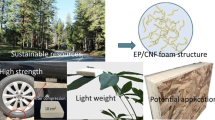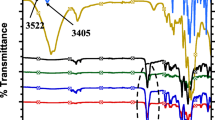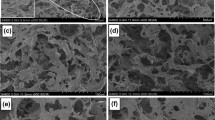Abstract
Plant-derived cellulose nanofibrils (CNFs) have shown reinforcing effects in polymer nanocomposites. However, freeze-dried CNFs are foam-like material, namely aerogel, that are challenging to disperse in a polymer matrix. In this work, a liquid infusion process was developed for a CNF/epoxy nanocomposite cross-linked foam structure with alterable properties without damaging the foam structure. Microstructures of CNF/epoxy composite foams with different formulations were evaluated using a scanning electron microscope. Surface morphology showed that the CNF cross-linked fibers were well attached by epoxy resin. All absolute and specific mechanical properties [by normalizing the measured parameters against the measured density (ρ)] were investigated. Water resistance and thermal stability of CNF/epoxy composite foams were investigated by water absorption test and thermogravimetric analysis. The concentration of epoxy solution in both tetrahydrofuran (THF) solvents and ethyl acetate (EA) solvents was shown to improve compressive properties and water resistance. The samples fabricated with higher epoxy concentration had higher compressive properties, better water resistance, and better thermal stability. The CNF/epoxy composite foams exhibited compressive modulus and compressive strength up to 175 and 10 MPa, respectively. The water diffusion coefficient of CNF/epoxy composite foams was reduced with an increase in epoxy loading. Further, the CNF/epoxy nanocomposite foams fabricated by the epoxy/THF solution had a more uniform structure and better strength performance than foams fabricated by the epoxy/EA solution, due to the increased solubility of the epoxy in THF compared to epoxy in EA. The glass transition temperature (Tg) was determined by differential scanning calorimetry. The Tg of the nanocomposites was influenced by the CNF/epoxy composition. Therefore, the properties of CNF/epoxy nanocomposite foams can be optimized via changing the solvent and concentration of epoxy resin in solvent.







Similar content being viewed by others
References
Fowler PA, Hughes JM, Elias RM (2006) Biocomposites: technology, environmental credentials and market forces. J Sci Food Agric 86:1781–1789
Zhang J, Luo N, Zhang X, Xu L, Wu J, Yu J et al (2016) All-cellulose nanocomposites reinforced with in situ retained cellulose nanocrystals during selective dissolution of cellulose in an ionic liquid. ACS Sustain Chem Eng 4:4417–4423
Huber T, Müssig J, Curnow O, Pang S, Bickerton S, Staiger MP (2012) A critical review of all-cellulose composites. J Mater Sci 47:1171–1186. doi:10.1007/s10853-011-5774-3
Lee S-Y, Chun S-J, Kang I-A, Park J-Y (2009) Preparation of cellulose nanofibrils by high-pressure homogenizer and cellulose-based composite films. J Ind Eng Chem 15:50–55
Khalil HPSA, Bhat AH, Yusra AFI (2012) Green composites from sustainable cellulose nanofibrils: a review. Carbohydr Polym 87:963–979
Jeronimidis G (1980) Wood, one of nature’s challenging composites. Symp Soc Exp Biol 34:169–182
Bledzki AK, Gassan J (1999) Composites reinforced with cellulose based fibres. Prog Polym Sci 24:221–274
Gebald C, Wurzbacher JA, Tingaut P, Zimmermann T, Steinfeld A (2011) Amine-based nanofibrillated cellulose as adsorbent for CO2 capture from air. Environ Sci Technol 45:9101–9108
Zhang Z, Sèbe G, Rentsch D, Zimmermann T, Tingaut P (2014) Ultralightweight and flexible silylated nanocellulose sponges for the selective removal of oil from water. Chem Mater 26:2659–2668
Yao C, Hernandez A, Yu Y, Cai Z, Wang X (2016) Triboelectric nanogenerators and power-boards from cellulose nanofibrils and recycled materials. Nano Energy 30:103–108
Chen B, Zheng Q, Zhu J, Li J, Cai Z, Chen L et al (2016) Mechanically strong fully biobased anisotropic cellulose aerogels. RSC Adv 6:96518–96526
Jung YH, Chang T-H, Zhang H, Yao C, Zheng Q, Yang VW et al (2015) High-performance green flexible electronics based on biodegradable cellulose nanofibril paper. Nat Commun 6:7170
Zheng Q, Javadi A, Sabo R, Cai Z, Gong S (2013) Polyvinyl alcohol (PVA)–cellulose nanofibril (CNF)–multiwalled carbon nanotube (MWCNT) hybrid organic aerogels with superior mechanical properties. RSC Adv 3:20816–20823
Yao C, Wang F, Cai Z, Wang X (2016) Aldehyde-functionalized porous nanocellulose for effective removal of heavy metal ions from aqueous solutions. RSC Adv 6:92648–92654
Lee Y, Choi J-W, Suh DJ, Ha J-M, Lee C-H (2015) Ketonization of hexanoic acid to diesel-blendable 6-undecanone on the stable zirconia aerogel catalyst. Appl Catal A 506:288–293
Buratti C, Moretti E, Belloni E, Agosti F (2014) Development of innovative aerogel based plasters: preliminary thermal and acoustic performance evaluation. Sustainability 6:5839–5852
Li Z, Yao C, Wang F, Cai Z, Wang X (2014) Cellulose nanofiber-templated three-dimension TiO2 hierarchical nanowire network for photoelectrochemical photoanode. Nanotechnology 25:504005
Zheng Q, Cai Z, Ma Z, Gong S (2015) Cellulose nanofibril/reduced graphene oxide/carbon nanotube hybrid aerogels for highly flexible and all-solid-state supercapacitors. ACS Appl Mater Interfaces 7:3263–3271
Zheng Q, Cai Z, Gong S (2014) Green synthesis of polyvinyl alcohol (PVA)–cellulose nanofibril (CNF) hybrid aerogels and their use as superabsorbents. J Mater Chem A 2:3110–3118
Hodgkin JH, Simon GP, Varley RJ (1998) Thermoplastic toughening of epoxy resins: a critical review. Polym Adv Technol 9:3–10
Li J, Hunt JF, Cai Z, Zhou X (2013) Bending analyses for 3D engineered structural panels made from laminated paper and carbon fabric. Compos Part B Eng 53:17–24
Li J, Hunt JF, Gong S, Cai Z (2016) Simplified analytical model and balanced design approach for light-weight wood-based structural panel in bending. Compos Struct 136:16–24
Li J, Hunt JF, Gong S, Cai Z (2016) Fatigue behavior of wood-fiber-based tri-axial engineered sandwich composite panels (ESCP). Holzforschung 70:567–575
Li J, Hunt JF, Gong S, Cai Z (2015) Testing and evaluation of a slot and tab construction technique for light-weight wood-fiber-based structural panels under bending. J Test Eval 44:357–366
Li J, Hunt JF, Gong S, Cai Z (2014) High strength wood-based sandwich panels reinforced with fiberglass and foam. BioResources 9:1898–1913
Saito T, Hirota M, Tamura N, Kimura S, Fukuzumi H, Heux L et al (2009) Individualization of nano-sized plant cellulose fibrils by direct surface carboxylation using TEMPO catalyst under neutral conditions. Biomacromolecules 10:1992–1996
Qing Y, Sabo R, Zhu J, Agarwal U, Cai Z, Wu Y (2013) A comparative study of cellulose nanofibrils disintegrated via multiple processing approaches. Carbohydr Polym 97:226–234
Standard A (2010) D695, 2010 standard test method for compressive properties of rigid plastics. ASTM International, West Conshohocken
Wei L, Liang S, McDonald AG (2015) Thermophysical properties and biodegradation behavior of green composites made from polyhydroxybutyrate and potato peel waste fermentation residue. Ind Crops Prod 69:91–103
Standard A (1998) D570-98: standard test method for water absorption of plastics. American Society for Testing and Materials, New York
Wei L, McDonald AG, Freitag C, Morrell JJ (2013) Effects of wood fiber esterification on properties, weatherability and biodurability of wood plastic composites. Polym Degrad Stab 98:1348–1361
Mueller S, Sapkota J, Nicharat A, Zimmermann T, Tingaut P, Weder C et al (2015) Influence of the nanofiber dimensions on the properties of nanocellulose/poly (vinyl alcohol) aerogels. J Appl Polym Sci 132:13
Kumar A, Negi YS, Choudhary V, Bhardwaj NK (2014) Characterization of cellulose nanocrystals produced by acid-hydrolysis from sugarcane bagasse as agro-waste. J Mater Phys Chem 2:1–8
Soni B, Mahmoud B (2015) Chemical isolation and characterization of different cellulose nanofibers from cotton stalks. Carbohydr Polym 134:581–589
Xu X, Liu F, Jiang L, Zhu J, Haagenson D, Wiesenborn DP (2013) Cellulose nanocrystals vs. cellulose nanofibrils: a comparative study on their microstructures and effects as polymer reinforcing agents. ACS Appl Mater Interfaces 5:2999–3009
Wan Y-J, Gong L-X, Tang L-C, Wu L-B, Jiang J-X (2014) Mechanical properties of epoxy composites filled with silane-functionalized graphene oxide. Compos Part A Appl Sci Manuf 64:79–89
Acknowledgements
This work is supported by USDA, Forest Products Laboratory and the authors gratefully acknowledge the support of James Bridwell of EMRSL group for the mechanical testing.
Author information
Authors and Affiliations
Corresponding authors
Ethics declarations
Conflict of interest
The authors declare that they have no conflict of interest.
Rights and permissions
About this article
Cite this article
Li, J., Wei, L., Leng, W. et al. Fabrication and characterization of cellulose nanofibrils/epoxy nanocomposite foam. J Mater Sci 53, 4949–4960 (2018). https://doi.org/10.1007/s10853-017-1652-y
Received:
Accepted:
Published:
Issue Date:
DOI: https://doi.org/10.1007/s10853-017-1652-y




